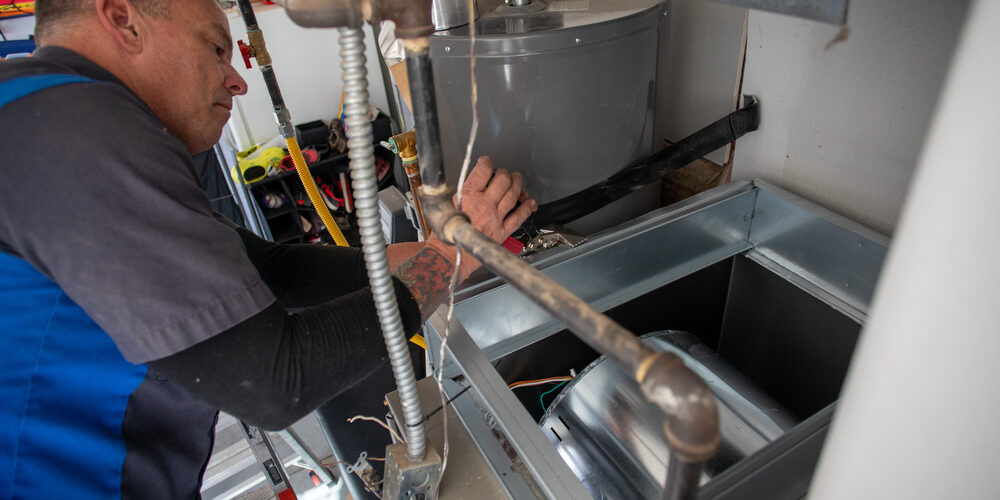Offices and homes rely heavily on HVAC systems to keep us comfortable all year. While these climate control systems provide invaluable temperature adjustments, what impact are HVAC systems having on their surroundings?
This article uncovers the impacts HVAC systems have on our planet. But don’t worry—it isn’t all doom and gloom; there are viable sustainable solutions that can ensure our cool and warm spaces leave a smaller carbon footprint. So, let’s get started!
Energy Consumption
HVAC systems account for 40% of commercial building energy usage while contributing 35% in residential structures, accounting for an immense portion of the electricity needs while straining grid infrastructure during peak usage times.
Many factors impact the power consumption of HVAC systems. This includes:
- Climate: Extreme temperatures place increased strain on HVAC systems as they attempt to provide comfortable indoor temperatures for their users.
- Building efficiency: Window leaks, poor insulation, and improper ductwork could all increase energy use considerably.
- System efficiency: The age and technology of the HVAC system play important roles. Older models are less efficient and more prone to energy waste.
GHG Emissions
Studies have demonstrated that approximately 10% of global CO2 emissions come from space cooling through refrigeration and air conditioners.
Here is an overview of how HVAC systems contribute to carbon dioxide emissions:
- Fossil fuel dependence: Burning natural gas and coal for electricity generation produces emissions such as NOx and CO2. These emissions contribute to heat absorption in the atmosphere, accelerating global warming.
- Refrigerant leaks: HVAC refrigerants such as hydrofluorocarbons (HFCs) are potent greenhouse gases. Any leakage could create major environmental risks even as regulations phase them out.
Water Consumption
HVAC systems are quite thirsty. Water consumption is mainly related to larger commercial buildings; however, it’s a crucial aspect to consider for environmental impacts in general.
Let’s see how HVAC systems impact the amount of water used:
- Cooling towers: Commercial buildings typically employ cooling towers as part of their central air cooling systems. They move heat from within a building’s water loop to the outside air via the process of evaporation, which requires constant supplies of water.
- Makeup water: Cooling systems are open, which means the water evaporates. To keep water levels in check, they require “makeup water” to be continuously added. This could strain water resources, particularly in areas prone to drought.
Noise Pollution
Although some modern models operate with a soft hum, older, poorly maintained HVAC systems could produce a chorus of unwelcome noises.
There are two major culprits for the noise produced by HVAC units:
- Airflow: The rumbling or whooshing sound commonly associated with HVAC systems is caused by the air moving through the ductwork. Improper duct layout, as well as tight bends or leaks, cause turbulent airflow, which can cause the airflow sound to get louder.
- Vibrations: Vibrations from compressors, fans, and other moving parts in HVAC systems amplify due to installation mistakes, worn bearings, or inadequate support, resulting in disruptive noise reverberating throughout the building.
Urban Heat Islands
HVAC systems are also a contributing factor to what’s called an urban heat island. Cities tend to be considerably warmer than rural regions. This results in increased demands for energy, health problems such as heat stroke, and worsened air quality.
Here’s how it will work:
- Waste heat exhaust: Air conditioning systems transfer hot air that is extracted from buildings to the outside via exhaust vents. The expelled heat gets absorbed in the urban environment and raises the ambient air temperature.
- Material selections: Most cities consist of asphalt, concrete, and dark-colored substances that absorb and store heat during the daytime. When nightfall arrives, this heat radiates back out, adding to the urban heat island effect.
Efficient HVAC Solutions For Sustainable Impact
The good news is that there are many options and sustainable methods we can use to reduce the environmental impact of HVAC. Some of them includes:
- Purchase Energy Star-Certified units: These models are independently tested to comply with stricter efficiency standards, which means they will reduce power consumption and lower electric costs.
- Improve the building envelope: Insulate attics, walls, and crawl spaces. Seal any air leaks around doors and windows to drastically decrease heat transfer while simultaneously relieving stress from HVAC systems.
- Regular HVAC maintenance: Plan regular HVAC maintenance visits to guarantee maximum system effectiveness and reduce energy use for temperature regulation.
- Light-reflective roofs: For use in hot climates, reflective or light-colored roofing materials should be considered to reduce heat absorption into buildings and consequently decrease cooling requirements.
- Utilize solar power: Solar energy can significantly offset your heating or air conditioning pump energy needs, decreasing your dependence on fossil fuels while simultaneously decreasing your carbon footprint.
- Natural ventilation: Take advantage of natural airflow by opening doors and windows during morning or evening cooler hours to improve circulation of air and increase natural cooling rates.
Conclusion
While essential to comfort, knowing the HVAC system’s environmental impact can help make better decisions. Implementing the sustainable solutions outlined here will lead to an eco-friendly future that pays off in lower costs, fewer carbon footprints, and increased satisfaction.
If you need expert advice and help with heating and ventilation St George, visit Kuhn’s Heating and Cooling. They offer energy-efficient solutions to keep your home comfortable year-round. You can visit Kuhn’s Heating and Air now to discover more!






